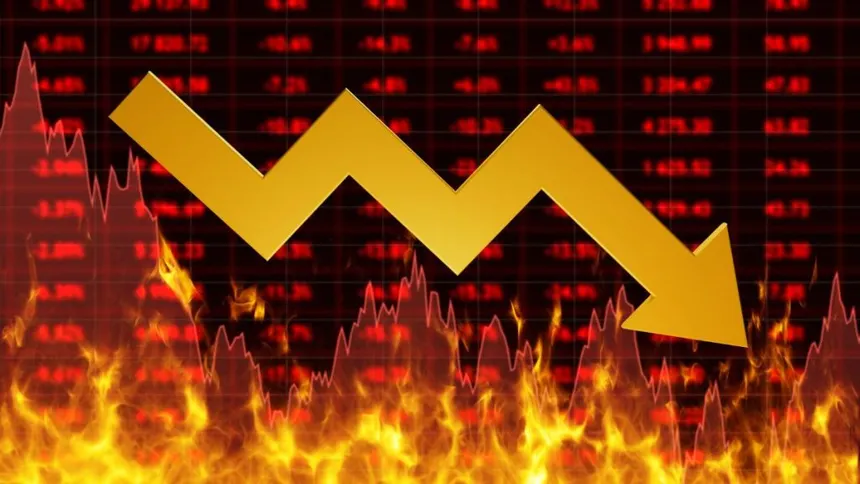The Indian stock market witnessed a sharp correction today, May 20, 2025, as both the Sensex and Nifty benchmarks tumbled significantly.

The Sensex crashed by a staggering 873 points, settling at 81,213.97, while the Nifty 50 slipped below the crucial 24,700 mark, closing at 24,683.90.1 This widespread market fall left investors questioning the sudden downturn after a period of robust gains. What exactly triggered this Indian stock market correction? Let’s dive into the key factors.
The Perfect Storm: Multiple Headwinds Explained
Several factors converged to create today’s stock market sell-off, painting a picture of cautious investor sentiment:
- Global Jitters: Moody’s US Credit Rating Downgrade
A major catalyst for today’s market decline stemmed from global markets. Moody’s recent US credit rating downgrade from AAA to Aa1, citing rising debt concerns, sent ripples across the world.2 This move raised fears of reduced liquidity in global markets, impacting emerging economies like India. Weak global cues from US futures further contributed to the negative sentiment.
- Institutional Selling Spree: FIIs Turn Net Sellers
Adding to the pressure, both Foreign Institutional Investors (FIIs) and Domestic Institutional Investors (DIIs) turned net sellers. FIIs pulled out significant capital, marking a cautious stance after their recent buying spree. This simultaneous FII outflows and DII selling was a notable shift and a key reason for the sharp decline, reducing the cushion provided by domestic flows.
- Profit Booking After Recent Rally
The Indian markets had witnessed a strong rally in the preceding weeks, pushing valuations to stretched levels. The Sensex and Nifty had surged, and many investors seized today’s opportunity to book profits at elevated levels. This profit booking was particularly visible in sectors that had seen significant gains.
- Pressure from Heavyweight Stocks
Selling pressure was concentrated in several heavyweight stocks across various sectors. Large-cap names, particularly in Nifty Bank, Financial Services, and Auto sectors, experienced significant declines. Prominent drags included HDFC Bank, Reliance Industries, ICICI Bank, M&M, Maruti, and Bajaj Finance, pulling the indices lower.
- Lingering Concerns: Election Uncertainty & Inflation
While not direct triggers for today’s sharp fall, underlying election uncertainty in India and persistent inflation concerns continue to contribute to a cautious outlook among some investors. Though recent inflation data showed some easing, the prospect of future interest rate decisions by the RBI remains a factor.
What Lies Ahead? Navigating the Volatility
Today’s market crash serves as a reminder of the inherent volatility in equity markets. While the immediate trigger points are clear, investors will be keenly watching for:
- Global Market Stability: Any further developments regarding the US economy and global liquidity will influence market sentiment.
- FII Flows: The trend in FII activity will be crucial. A sustained return of foreign inflows could provide much-needed support.
- Domestic Triggers: Local economic data, corporate earnings, and any policy announcements will be key drivers.
- Technical Levels: Analysts will be scrutinizing key support and resistance levels for Sensex and Nifty to gauge the market’s direction.
Technical Breakdown Adds Pressure
Nifty breached the crucial support level of 24,800, triggering panic selling and stop-loss hits. Analysts believe if Nifty closes below 24,600 in the coming days, further downside towards 24,200 can’t be ruled out
What Should Investors Do Now?
Market experts advise caution and a wait-and-watch approach. While this may be a healthy correction, investors should avoid panic selling and focus on long-term fundamentals.
Pro Tip: Keep an eye on the upcoming RBI policy, US Fed updates, and FII flows – these will be key to short-term market direction.
Conclusion.
In conclusion, today’s Indian stock market fall was a confluence of global concerns, institutional selling, and profit booking. While such corrections are a normal part of market cycles, understanding the underlying reasons is crucial for investors to navigate the road ahead. Staying informed and exercising caution amidst volatility will be paramount.
Anurag Dhole is a seasoned journalist and content writer with a passion for delivering timely, accurate, and engaging stories. With over 8 years of experience in digital media, she covers a wide range of topics—from breaking news and politics to business insights and cultural trends. Jane's writing style blends clarity with depth, aiming to inform and inspire readers in a fast-paced media landscape. When she’s not chasing stories, she’s likely reading investigative features or exploring local cafés for her next writing spot.






